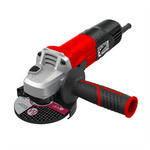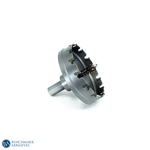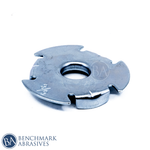
Types of Hacksaw Blades and Uses

Hacksaws come in a variety of shapes and sizes, and all have a different purpose. A hacksaw is a tool you can find in every home, although in various sizes. A hacksaw is a small-toothed, hand-powered tool used to cut metal pipes, rods, and brackets. Plastic can also be cut with hacksaws. Hacksaws were designed primarily to cut metal, but they can also cut a variety of other materials.
A C-shaped walking frame maintains a blade under tension in most hacksaws. Pins are used to join a narrow disposable blade to the handle, which is often a pistol grip. The frames could also be adjusted to accommodate different blade sizes. A screw or similar mechanism is used to tension the thin blade. On hacksaws, like most frame saws, the blade can be held with the teeth on or away from the handle, resulting in a cutting action on a push or draw stroke. When cutting vertically downward with the work held in the bench vise, the hacksaw blades are generally facing forward.
Hacksaw blades are often categorized as flexible or hardened, with differences in coarseness, tooth pitch, and length to consider while selecting the right hacksaw for the job. Understanding the various types of hacksaws and their uses should be tough for a beginner. As a result, we are here with this article to help you know hacksaws, their types, and their applications.
Types Of Hacksaw Blades and Their Uses
Hacksaws are available in a variety of sizes to suit a variety of tasks. Choosing the right hacksaw blade isn't just about the material you're cutting; it's also about the desired finish and efficiency. The "grade" of a hacksaw blade refers to the coarseness of its teeth, measured in TPI (teeth per inch). For softer, thicker materials, choose a lower TPI. For harder, thinner materials, a higher TPI will give you a cleaner cut. Using the wrong blade can lead to slower cutting, premature blade wear, or a poor finish on your workpiece. Below are the types of hacksaw blades:
- Course grade hacksaw blade
- Medium-grade hacksaw blade
- Fine grade hacksaw blade
- Superfine grade hacksaw blade
- All hard blades
1. Course Grade Hacksaw Blade
This hacksaw blade is used to cut mild steel, copper, aluminum, and brass, among other materials. In simple words, course grade hacksaw blades are excellent for thick materials since they have a lower 14-18 TPI(teeth per inch)
2. Medium Grade Hacksaw Blades
Medium-grade hacksaw blades are excellent all-around hacksaw blades. Most metals can be cut with a bit more ease with these blades than with the coarse grade. These hacksaw blades may struggle with thicker metal projects, but they are the superior option for cast iron. It has 20-24 TPI.
3. Fine Grade Hacksaw Blade
Fine-grade hacksaw blades are used for thin materials, such as sheet metal and thin-walled tubes, such as electrical conduit and copper piping. They cut more finely and do not leave a rough border for wires to drag on, making them great for electrical work. They have 24-30 TPI.
4. Superfine Grade Hacksaw Blade
Superfine hacksaw blades are used to cut fine metals and thin sheets. Typically has 30-32 TPI
5. All Hard Blade
All hard blades are also hacksaw blades that are extremely fine (30-32 TPI). These blades have been hardened and tempered to reduce brittleness and help them stay sharper for longer. These are used to cut cast iron or mold iron, among other materials.
What is TPI?
The term TPI means "number of teeth per inch," or you can say the number of teeth per inch on a saw blade. The higher the TPI number of the blade, the finer and cleaner the cut will be. High TPI saw blades can cut both hard and soft metals.
How To Use a Hacksaw?
Here are the steps for using a hacksaw:
Step 1: Tighten and tension the blade: Make sure the hacksaw blade is securely bolted to the frame and properly tensioned. A well-tensioned blade prevents bending and ensures a clean cut.
Step 2: Measure and mark: Accurately measure the desired length on your pipe, tube, or other material and mark the cutting line.
Step 3: Position the blade: Position the hacksaw blade exactly over the marked line on your material.
Step 4: Saw with back-and-forth strokes: Begin cutting with gentle, steady, back-and-forth strokes. Apply pressure during the forward stroke and ease off slightly on the return stroke. To maximize efficiency, use the entire length of the blade.
Safety Measures While Using a Hacksaw
Make safety a priority when using a hacksaw to avoid injury.
- Always wear safety glasses to protect your eyes from flying debris.
- To guarantee a stable cutting surface and prevent jerking, hold your workpiece securely in a vice.
- Ensure the blade is tensioned correctly and you've chosen the right blade for your material.
- Apply pressure only on the forward stroke and use a fluid, steady stroke.
- Avoid placing your free hand in the path of the blade. To prevent the saw blade from breaking, do not apply force to it.
- To avoid unintentional cuts, store the hacksaw safely after use by securing the blade.
Hacksaws are great tools and easy to work with. Just make sure you choose the right blade for the right material.



































































